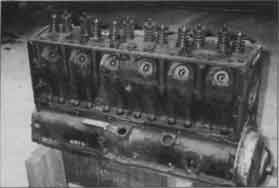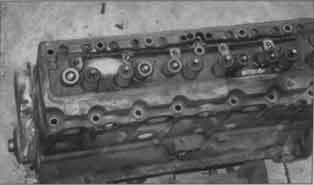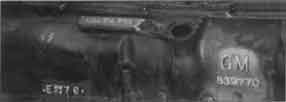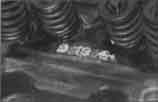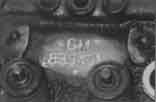
Adler's Antique Autos, Inc.
Author of "Notes from the Corrosion Lab"
801 NY Route 43, Stephentown, NY 12168
(518) 733 - 5749 Email
|
Articles
|
Part 4 of a Series
"What's Under the Hood?
by Bob Adler
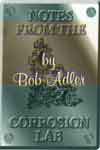
There are many identifying characteristics on major truck components, with the engine being the most important. Knowledgeable friends might say, Yup, it?s a Chevy 216 fer sure. It has a tall side cover and two studs poking through the rocker cover. They may be correct, but it?s better to find more reliable sources for identification. The following will help confirm what you have under the hood and determine if the factory put it there.
Casting numbers
Most, if not all, of the cast-iron components that General Motors produced have numbers in the original molds. Other makes cast similar identifying numbers in their large components. I pulled the engine out of a 1946 Chevy half-ton that was being restored, and cast just ahead of the distributor is the number GM 839770. I punched this number into an internet search engine and it led me to a website from Hemmings Motor News clubs, which had a useful table.
Chevrolet 6-cylinder 216ci Cylinder Block Casting Numbers 1937 to 1962
From this table I surmised the engine is a 1942 or 1946 Chevy 216. However, the internet makes anyone a publisher, which produces a lot of misinformation. We need to use more sources to confirm our engine's exact origins.
Another website, from Inliners Intemational, high-performance 6-cylinder engine enthusiasts, lists 839770 as a Chevy 216ci, 1942-53. Classic Truck Shop's website also associates this casting number with a 1942-53 Chevy 216ci. Neither of these two sources listed the stamped numbers, which appear in the middle column of the table.
My favorite source for casting numbers is the Hollander Interchange Manual. The 16th edition of 1949 says 839770 Chev 42-47 All w/216 Eng. The 23rd edition of 1956 does not list this engine number. The Chevrolet Master Parts List 1929-1942 does not list this number. The 1950 version says 839770 1942-47 all with 216 engine. The casting number is not the part number. The part number, which is 606537, also appears in the 1942 Master Parts List, but it did not have a cross reference to the casting number, so I could not identify it solely from that source.
Casting dates
Another number on many cast parts is the date code. On Chevy 6-cylinder engines, it is just behind the starter. The casting date number on the engine block in this vehicle is B 17 6. Decoded it reads: E, fifth month, May; 17 day of the month; 6 last digit of the year, 1946.
The factory would season or age these blocks for a month or so, then machine and assemble them. Right after World War II, with a shortage of new cars and trucks, I bet the manufacturers eliminated the aging process. So, the engines would be installed in a chassis soon after the casting date.
|
Serial numbers
This truck's serial number is 9DPF 1255. When it is decoded, the number reads: 9, Norwood, Ohio, assembly plant; D, 1946; P, half-ton; F, June assembly date; 1255, the sequence in June, indicating an assembly date of June 1946.
This is a good indication that the original engine is in this 1946 truck, and that the builders cast, machined, and installed this engine block without wasting any time.
ID numbers
The last identifier on the block is a stamped number just to the rear of the distributor. On this truck, it reads DBA 74393. Cars & Parts Catalog of Chevy Truck ID Numbers 1946-1972 lists DBA as a 1946 216ci. From Chevrolet Engineering Specifications we find DBA indicates it is from the Flint, Michigan, foundry and was installed as regular production on half-tons in 1946. From all this evidence, we can be relatively sure that this is the original engine block. Note the Hemmings club website got this part wrong in its middle column.
|
Cylinder head
The cylinder has a casting number of 839401. Our internet source at the Hemmings club website says 1941-48 839401 All 216 and 235. Chevrolet Master Parts Catalog 1942 does not have this casting number listed, but says 839409 is the part number (not casting number) for 1941-42. The 1950 edition also does not list this as currently available. For 1941-49 the parts catalog suggests using another head with 14-mm spark plugs. The original head takes tiny 10-mm plugs. Possibly the small plugs were not as effective as the larger ones used before and after, since the head taking smaller plugs was discontinued quickly. Hollander for 1949 lists 839409 and 838401 for Chev 41-48 all Civilian & Army. Hollander for 1956 indicates 839401 is the casting number for 1941-48.
The date code is D 196 for April 19, 1946. How do we know it is not 1956 or 1936? These date codes repeat every 10 years. GM did not use a casting number on major components for more than one decade. So 1936 and 1956 heads are physically different and have other casting numbers, but would have the same casting dates.
Transmission casting
For a transmission casting number of 591195, nothing automotive is available on the internet. However, the 1949 Hollander reads: Chev Tr. 4 1-47 l/2-3/4T. 3 spd. The 1956 Hollander says: 591195 is casting No. for 591194, Chev Tr. 41-47 1/2-1T. 3 spd. Master Parts Catalog 1929-1942 lists 591194 for 1941 1/2- and 3/4-ton. The 1950 edition lists part 591194, cast 591195, for 1941-47A11 Coin (3-speed).
Date code B 18 6 is close to the dates of the other components.
The serial number stamped on the top rear of the housing is DO 19009. The Cars & Parts identification number book decodes this as D for 1946, 0 for a three-speed, half-ton from the Muncie, Indiana, plant. Chevrolet engineering specifications confirms this.
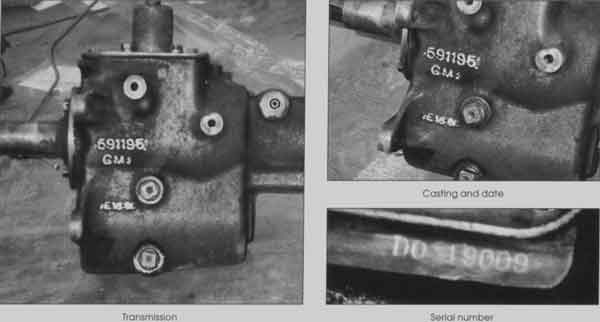
|
Conclusion
There is no single best source of information on what's original. If you find two sources in agreement, it raises the level of confidence. Three sources would be better. I discussed restoration source books in detail in the July/August 1999 issue of This Old Truck.
Cars & Parts has a Ford truck identification numbers book as well as the Chevy book mentioned. Both are currently in print and available from This Old Truck. Hollander has reprints of its 1949, 1956, 1965, and 1973 editions currently available. Remember, though, that most of these sources contain some errors.
Internet publishing seems to take print misinformation and magnify it, so always confirm information from the internet. Original factory sources have the highest level of accuracy. The numbers on the three components discussed indicate they most likely came on this truck from the factory, but we can't be 100 percent certain. The owner of this 1946 truck, said his grandfather bought it used. I would say we're 99.9 percent certain the drivetrain is the original one installed at the assembly plant. The components could have been assembled from parts trucks, but it's not likely based on this truck's history.
Note the casting date code is easy to remember and it alone gives a good indication of authenticity. It is found on many components.
Bob Adler is owner of Adler's Antique
Autos, Stephentown, New York, and
specializes in GM truck restoration.
He can be reached at 518-733-5749.
Email
